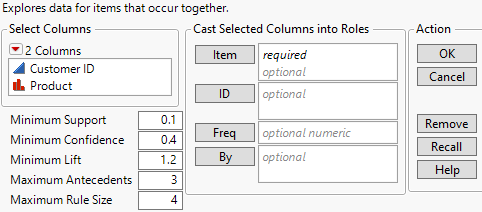 Launch the Association Analysis Platform
Launch the Association Analysis Platform
Launch the Association Analysis platform by selecting Analyze > Screening > Association Analysis.
Figure 24.4 Association Analysis Launch Window
For more information about the options in the Select Columns red triangle menu, see Column Filter Menu in Using JMP.
Item
The categorical column or columns that contain the item data to be analyzed. If the column has the Multiple Response modeling type, each of the multiple responses in each row is treated as an item. If multiple columns are specified, each column in each row is treated as an item.
ID
The column that identifies the transaction to which an item belongs. The ID role is required, unless the Item role is filled by a column with the Multiple Response modeling type or the Item role is filled by multiple columns.
Note: If an ID role is specified, all rows with the same ID are combined into one transaction.
Freq
The column that identifies a frequency for the transactions in the Item column. For example, if a transaction has a frequency of 3, that is treated as three identical transactions that contain the items in the Item column.
Note: The Freq role is ignored if the Item role is filled by a column that does not have the Multiple Response modeling type.
By
Produces a separate report for each level of the By variable. If more than one By variable is assigned, a separate report is produced for each possible combination of the levels of the By variables.
Minimum Support
Specifies a minimum value for the proportion of occurrences of an item set. This value must be between 0 and 1. Only item sets with support equal to or exceeding this value are considered in the analysis.
Minimum Confidence
Specifies a minimum value for the proportion of occurrences that a consequent item set occurs within transactions that contain the conditional item set. This value must be between 0 and 1. Only association rules with confidence equal to or exceeding this value appear in the report.
Minimum Lift
Specifies a minimum dependency ratio. Lift values must be 0 or greater. Only association rules with lift equal to or exceeding this value appear in the report.
Maximum Antecedents
Specifies the maximum number of items in the condition item set. Association rules with more than this number of items in the condition set are not considered in the analysis.
Maximum Rule Size
Specifies the maximum number of items that appear in the union of the condition and consequent item sets. Association rules with more than this combined number of items are not considered in the analysis. The default value is 4.
Note: You can use the minimum support, maximum antecedent, and maximum rule size options in the launch window to reduce computational time for large data sets. For more information about these measures, see Statistical Details for the Association Analysis Platform.
Data Format
There are three data formats that are accepted in the Association Analysis platform:
• You can specify a single item response in each row in the Item role and identify which items are included in each transaction using the ID role. In this format, the Item and ID roles are required and the Freq role is ignored.
• You can specify a Multiple Response modeling type column for the Item role. In this format, the Item role is required, the ID and Freq roles are optional. If an ID role is specified, all rows with the same ID are combined into one transaction. If a Freq role is specified, the frequency applies to the transaction, not the specific items in the transaction.
• You can specify multiple item response columns in the Item role. In this format, the ID and Freq roles are optional. If an ID role is specified, all rows with the same ID are combined into one transaction. If a Freq role is specified, the frequency applies to the transaction, not the specific items in the transaction.
